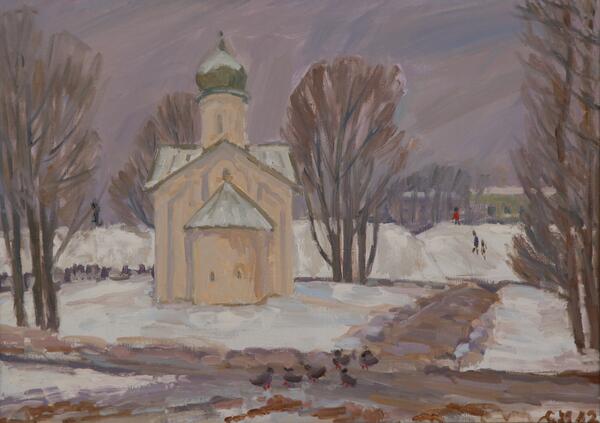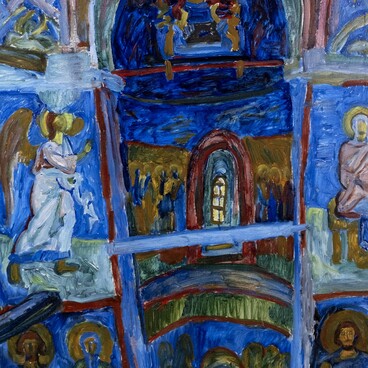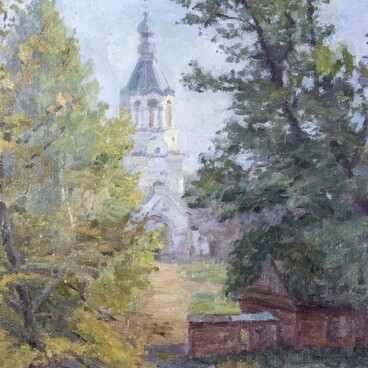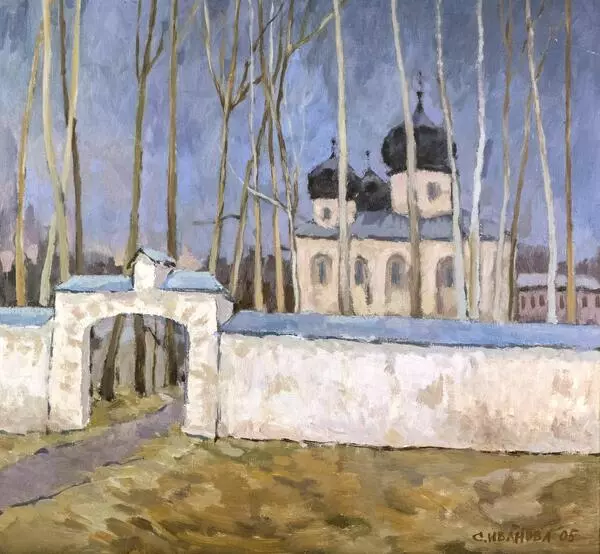Svetlana Evgenievna Ivanova is a famous figure in Novgorod. She is an active participant in various exhibitions and plein-air sessions, a member of the Artists’ Union of Russia Federation, and an organizer of student exhibitions. The artist graduated with honors from the Art Department of the Yaroslav-the-Wise Novgorod University. She prefers to paint with pastels and oils. Svetlana Evgenievna likes to depict architectural monuments in her landscapes, making them an organic part of the nature.
This winter landscape depicts the mid-15th century Church of the Twelve Apostles, which is located in the Sophia Side, in the Zagorodsky End (borough) of the city.
The first wooden church stood on this site in as early as the 13th century. The Voskresenskaya (“Resurrection”) Chronicle reports that in 1230, during a severe epidemic, Archbishop Spyridon allocated land near the church for a potter’s field, or a paupers’ grave, — a common grave for those who died suddenly, without communion. The humble icon painter Stanila was assigned to bring the corpses there “on horseback” until the potter’s field was filled to the brim. The burial place was a naturally-formed pit near the church. In historical sources, it is referred to as “the pit”, later the church became popularly known as the Church of the Twelve Apostles “on the Abyss”.
The wooden church was damaged several times in fires, and in 1358/1359, the posadnik (mayor) Andreyan Zakharinich, a representative of Prussian Street and Carpenter’s End, and Danila Kozmin built a new stone church on this site. The information concerning its history is contradictory. Presumably, the church was about twice the size of the one that was built later, but for some unknown reason it was destroyed in the early 15th century.
Under Archbishop Evfimy, in 1432, another wooden church was again erected there. In 1454/1455, it was replaced with a stone one, and later it was rebuilt several times and various buildings were added to it.
After the destruction of the Novgorodian shrines by the Swedes in the early 17th century, only the deserted church remained near the former potter’s field. However, the monastery was restored.
According to Archbishop Makarii, in the 19th century this site with a garden and a courtyard was called Metropolitan (Vladychny) Island and belonged to the Archbishop’s House of St. Sophia.
This winter landscape depicts the mid-15th century Church of the Twelve Apostles, which is located in the Sophia Side, in the Zagorodsky End (borough) of the city.
The first wooden church stood on this site in as early as the 13th century. The Voskresenskaya (“Resurrection”) Chronicle reports that in 1230, during a severe epidemic, Archbishop Spyridon allocated land near the church for a potter’s field, or a paupers’ grave, — a common grave for those who died suddenly, without communion. The humble icon painter Stanila was assigned to bring the corpses there “on horseback” until the potter’s field was filled to the brim. The burial place was a naturally-formed pit near the church. In historical sources, it is referred to as “the pit”, later the church became popularly known as the Church of the Twelve Apostles “on the Abyss”.
The wooden church was damaged several times in fires, and in 1358/1359, the posadnik (mayor) Andreyan Zakharinich, a representative of Prussian Street and Carpenter’s End, and Danila Kozmin built a new stone church on this site. The information concerning its history is contradictory. Presumably, the church was about twice the size of the one that was built later, but for some unknown reason it was destroyed in the early 15th century.
Under Archbishop Evfimy, in 1432, another wooden church was again erected there. In 1454/1455, it was replaced with a stone one, and later it was rebuilt several times and various buildings were added to it.
After the destruction of the Novgorodian shrines by the Swedes in the early 17th century, only the deserted church remained near the former potter’s field. However, the monastery was restored.
According to Archbishop Makarii, in the 19th century this site with a garden and a courtyard was called Metropolitan (Vladychny) Island and belonged to the Archbishop’s House of St. Sophia.




